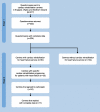Why do so few patients with heart failure participate in cardiac rehabilitation? A cross-sectional survey from England, Wales and Northern Ireland
- PMID: 22454188
- PMCID: PMC3323807
- DOI: 10.1136/bmjopen-2011-000787
Why do so few patients with heart failure participate in cardiac rehabilitation? A cross-sectional survey from England, Wales and Northern Ireland
Abstract
Objectives: To determine why so few patients with chronic heart failure in England, Wales and Northern Ireland take part in cardiac rehabilitation.
Design: Two-stage, postal questionnaire-based national survey.
Participants and setting: Stage 1: 277 cardiac rehabilitation centres that provided phase 3 cardiac rehabilitation in England, Wales and Northern Ireland registered on the National Audit of Cardiac Rehabilitation register. Stage 2: 35 centres that indicated in stage 1 that they provide a separate cardiac rehabilitation programme for patients with heart failure.
Results: Full data were available for 224/277 (81%) cardiac rehabilitation centres. Only 90/224 (40%) routinely offered phase 3 cardiac rehabilitation to patients with heart failure. Of these 90 centres that offered rehabilitation, 43% did so only when heart failure was secondary to myocardial infarction or revascularisation. Less than half (39%) had a specific rehabilitation programme for heart failure. Of those 134 centres not providing for patients with heart failure, 84% considered a lack of resources and 55% exclusion from commissioning contracts as the reason for not recruiting patients with heart failure. Overall, only 35/224 (16%) centres provided a separate rehabilitation programme for people with heart failure.
Conclusions: Patients with heart failure as a primary diagnosis are excluded from most cardiac rehabilitation programmes in England, Wales and Northern Ireland. A lack of resources and direct exclusion from local commissioning agreements are the main barriers for not offering rehabilitation to patients with heart failure.
Conflict of interest statement
References
-
- Adams KF. Translating heart failure guidelines into clinical practice: clinical science and the art of medicine. Curr Cardiol Rep 2001;3:130–5 - PubMed
-
- Bethell HJ, Evans JA, Turner SC, et al. The rise and fall of cardiac rehabilitation in the United Kingdom since 1998. J Public Health (Oxf) 2007;29:57–61 - PubMed
-
- Hunt SA, Abraham WT, Chin MH, et al. 2009 focused update incorporated into the ACC/AHA 2005 guidelines for the diagnosis and management of heart failure in adults: a report of the American College of Cardiology Foundation/American heart Association Task Force on practice guidelines developed in collaboration with the international Society for heart and Lung Transplantation. Circulation 2009;119:e391–479 - PubMed
-
- Dickstein K, Cohen-Solal A, Filippatos G, et al. ESC guidelines for the diagnosis and treatment of acute and chronic heart failure 2008: the Task Force for the diagnosis and treatment of acute and chronic heart failure 2008 of the European Society of Cardiology. Developed in collaboration with the heart failure Association of the ESC (HFA) and endorsed by the European Society of Intensive care medicine (ESICM). Eur Heart J 2008;29:2388–442 - PubMed
-
- European Heart Failure Training Group Experience from controlled trials of physical training in chronic heart failure. Protocol and patient factors in effectiveness in the improvement in exercise tolerance. Eur Heart J 1998;19:466–75 - PubMed
Grants and funding
LinkOut - more resources
Full Text Sources
Other Literature Sources

